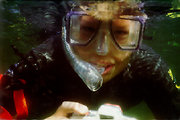Snorkel
|
|
de:Schnorchel fr:tuba (plongée) nl:snorkel
| Contents |
Swimmer's snorkel
Snorkel.JPG
A snorkel is a tube about 30 cm / 12 inches long, usually J-shaped, fitted with a reasonably comfortable mouthpiece, and constructed of rubber or plastic. It is used for breathing air from above the water surface when the mouth and nose are submerged, either during a surface swim before or after scuba diving, or during snorkeling.
The most common type of snorkel is a simple tube that is allowed to flood when underwater. The snorkeller expels water from the snorkel with a sharp exhalation on return to the surface. Some modern snorkels have a sump in the mouthpiece to allow a small volume of water to remain in the snorkel without being inhaled when the diver breathes. Some have a one-way output valve in the sump, which automatically drains the sump as it fills with water. Some snorkels have float-operated valves attached to the surface end of the tube to keep water out when the snorkeller submerges.
The maximum length of the tube is around 50 cm / 18 inches. A longer tube would place the lungs in deeper water where the surrounding water pressure is higher and the lungs would be unable to inflate when the diver inhales, because the muscles that expand the lungs are not strong enough to operate against the higher pressure.
Submarine snorkel
A snorkel (also spelled "schnorkel" and "schnorchel") is also a device that allows a submarine to operate submerged while still taking in air from above the surface. It was invented by the Dutch just before World War II and perfected by the Germans during the war for use by U-boats.
Until the advent of nuclear power, submarines were designed to operate on the surface most of the time and submerge only for evasion or for rare daylight attacks. In 1940 at night a U-boat was safer on the surface than submerged, because ASDIC could detect boats underwater but was useless against a surface vessel. However, with the continued improvement in methods of detection and attack as the war progressed, the U-boat was forced to spend more and more time underwater, running on electric motors which gave speeds of only a few knots and had very limited endurance.
The 1940 defeat of the Netherlands by the Wehrmacht was a stroke of luck for the Kriegsmarine. The Dutch had been working on a device that the German called somewhat rudely the "Schnorchel". The Dutch navy had been experimenting as early as 1938 with a simple pipe system on the submarines O-19 and O-20, which enabled them to operate at periscope depth to operate its diesels and thus have almost unlimited underwater range.
The Kriegsmarine at first gave some consideration to the snorkel as a means to take fresh air into the boats but saw no need to run the diesel engines underwater. In 1943, however, as more U-boats were lost, it was retrofitted to the VIIC and IXC classes and designed into the new XXI and XXIII types.
The first boat to be fitted with a snorkel was U-58 which experimented with the equipment in the Baltic during the summer of 1943. Boats began to use it operationally in early 1944 and by June 1944 about half of the boats stationed in the French bases had snorkels fitted.
On Type VII boats the snorkel folded forward and was stored in a recess on the port side of the hull while on the IX Types the recess was on the starboard side. The XXI and XXIII types both had telescopic masts that rose vertically through the conning tower close to the periscope.
Snorkels created several problems for their users. A U-boat with a snorkel raised was limited to six knots to avoid breaking the tube, and its sound detection gear was deafened by the roaring of the air being sucked down the tube. A submarine that stayed underwater for more than a few hours encountered various disposal problems, and had to store garbage internally, further fouling boats already infamous for their odors. Most dramatically, snorkels were equipped with automatic valves to prevent seawater from being sucked into the diesels, but when these valves slammed shut, the engines would draw air from the boat itself before shutting down, which was extremely painful to the ears of the crew and sometimes even ruptured eardrums. (This last problem still exists in modern submarines, though their larger internal volumes of air mitigates the pain somewhat.)
Vehicle snorkel
A snorkel is also an aftermarket accessory fitted to some four wheel drive vehicles to allow them to drive through deep water without drawing water into the engine. They are typically routed out through one of the front wings and up beside the "A" pillar to the level of the roofline where they are terminated with either a mushroom intake or a forward facing intake.
External Links
Snorkel reviews (http://www.thescubaguide.com/d/-3-1.aspx) - read user reviews of snorkels from the Scuba Guide. Experienced scuba divers rate and suggest the best snorkels.

